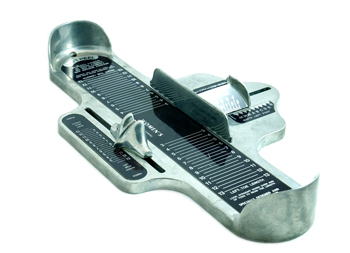Items filtered by date: October 2022
Shoes That Are Too Big, Too Small, and Just Right

There are various foot conditions that can be caused by wearing shoes that do not fit correctly. Bunions, hammertoes, and ingrown toenails are some of these ailments, and getting the right shoe size may help to prevent these from developing. It is imperative to determine what your correct shoe size is before any purchases are made. This can be done by using the Brannock device that is found in most shoe stores, which can measure the length and width of your foot. Once the size has been determined, the next step is to choose a pair that is pleasing to the eye, then try them on. This is followed by walking around in them for a short period of time in the store, which is when most people can tell if the shoe is right for them. If the shoes are too tight, they may cause blisters or corns to develop, and may need to be purchased in a half or more size larger. If the shoes are too big, they may slip on your feet, and this can increase the risk of falling. If you would like more information about how to find the right shoe size for you, please consult a podiatrist who can help you to make the right choice.
Getting the right shoe size is an important part of proper foot health. Seek the assistance of Dr. Scott Peters from Ankle & Foot Walk-In Clinic. Our doctor will provide the care you need to keep you pain-free and on your feet.
Getting the Right Shoe Size
There are many people who wear shoes that are the incorrect size, negatively affecting their feet and posture. Selecting the right shoes is not a difficult process, so long as you keep several things in mind when it comes to choosing the right pair.
- When visiting the shoe store, use the tools available to measure your foot.
- Be sure there is ‘wiggle room’. There should be about an inch between your toes and the tip of your shoes.
- Do not always assume you are the same size, as manufacturers run differently.
- Purchase shoes later in the day, as your feet swell as the day progresses.
- If a shoe is not comfortable, it is not suitable. Most shoes can’t be ‘broken in’, and comfort should be the ultimate goal when it comes to choosing the right pair of shoes
As our feet hold our body weight and keep us moving, it is important to treat them right. Picking the right pair of shoes can provide your feet comfort and mobility without pain.
If you have any questions, please feel free to contact our office located in Mayfield Village, OH . We offer the newest diagnostic and treatment technologies for all your foot care needs.
Gout Pain Can Be Managed
Reasons Cracked Heels Can Develop

The foot condition that is known as cracked heels often comes from having extremely dry skin. This can happen for a number of reasons, including medical conditions consisting of eczema and psoriasis. Additionally, wearing shoes that have an open back may cause this ailment to develop, or it may also come from standing on hard surfaces for the majority of the day. Cracked heels can cause pain and discomfort, and mild relief may be found when a good moisturizer is frequently used. Many patients find it helpful to soak their feet in warm water, although this may only provide temporary relief. There are effective methods that may help to prevent cracked heels from developing, including wearing shoes that have a closed back, and choosing what type of surface to stand on, if possible. It may help to avoid taking hot showers, in addition to refraining from using lotions that may contain alcohol. If you have cracked heels, please consult with a podiatrist who can recommend the correct treatment option for you, which may include using a prescription cream.
If the skin on your feet starts to crack, you may want to see a podiatrist to find treatment. If you have any concerns, contact Dr. Scott Peters from Ankle & Foot Walk-In Clinic. Our doctor can provide the care you need to keep you pain-free and on your feet.
Cracked Heels
It is important to moisturize your cracked heels in order to prevent pain, bleeding, and infection. The reason cracked heels form is because the skin on the foot is too dry to support the immense pressure placed on them. When the foot expands, the dry skin on the foot begins to split.
Ways to Help Heal Them
- Invest in a good foot cream
- Try Using Petroleum Jelly
- Ease up on Soaps
- Drink Plenty of Water
Ways to Prevent Cracked Heels
- Moisturize After Showering
- Skip a Shower
- Keep Shower Water Lukewarm
- Don’t Scrub Your Feet
If you are unsure how to proceed in treating cracked heels, seek guidance from a podiatrist. Your doctor will help you with any questions or information you may need.
If you have any questions, please feel free to contact our office located in Mayfield Village, OH . We offer the newest diagnostic and treatment technologies for all your foot care needs.
Achilles Tendon Pain

The Achilles tendon connects the muscles of the calf and lower leg to the heel bone. When it is stretched beyond its limits, it can become inflamed (called tendonitis) or tear (also known as a rupture). Injuries to the Achilles tendon can cause mild to severe pain and stiffness. Achilles tendonitis can come on from a variety of reasons, including sudden increase in exercise, insufficient stretching of the calf muscle, flat feet, a bony spur on the back of the ankle, or leg length differences. The pain one feels with this inflammatory condition can be felt near the bottom of the calf muscle, along the tendon, or near the heel bone and is described as a burning sensation that worsens with activity. There may be mild swelling and warmth in the affected area and some stiffness, especially before warming up. Untreated, tendonitis can progress to tendinosis, which is when the collagen fibers that make up the tendon break down. There is no inflammation with tendinosis, but scar tissue may result from this and lead to permanent thickening. An Achilles tendon rupture is rarer but happens when the tendon fibers tear and separate completely or in part. This can occur from sudden force being exerted on the tendon, severe overstretching causing the tendon to tear, or taking a type of antibiotic called fluoroquinolones. This will bring on severe heel pain and an inability to walk or bear weight on the foot. If you feel Achilles tendon pain, it is best to consult with a podiatrist for a proper diagnosis and treatment that is right for you.
Achilles tendon injuries need immediate attention to avoid future complications. If you have any concerns, contact Dr. Scott Peters of Ankle & Foot Walk-In Clinic. Our doctor can provide the care you need to keep you pain-free and on your feet.
What Is the Achilles Tendon?
The Achilles tendon is a tendon that connects the lower leg muscles and calf to the heel of the foot. It is the strongest tendon in the human body and is essential for making movement possible. Because this tendon is such an integral part of the body, any injuries to it can create immense difficulties and should immediately be presented to a doctor.
What Are the Symptoms of an Achilles Tendon Injury?
There are various types of injuries that can affect the Achilles tendon. The two most common injuries are Achilles tendinitis and ruptures of the tendon.
Achilles Tendinitis Symptoms
- Inflammation
- Dull to severe pain
- Increased blood flow to the tendon
- Thickening of the tendon
Rupture Symptoms
- Extreme pain and swelling in the foot
- Total immobility
Treatment and Prevention
Achilles tendon injuries are diagnosed by a thorough physical evaluation, which can include an MRI. Treatment involves rest, physical therapy, and in some cases, surgery. However, various preventative measures can be taken to avoid these injuries, such as:
- Thorough stretching of the tendon before and after exercise
- Strengthening exercises like calf raises, squats, leg curls, leg extensions, leg raises, lunges, and leg presses
If you have any questions please feel free to contact our office located in Mayfield Village, OH . We offer the newest diagnostic tools and technology to treat your foot and ankle needs.
Negative Consequences of Working on Your Feet

If you are a worker that spends the vast majority of the workday on your feet, you might be putting yourself at an increased risk of developing a foot condition or affliction. For example, if someone stands for a prolonged period of time, experiencing swollen feet, heart problems, or circulatory problems could become more likely. To address these issues, one might consider intentionally taking breaks throughout the workday to sit down and rest. During these breaks, an individual might also consider stretching the feet, perhaps flexing and pointing them. Reach out to your podiatrist to schedule an appointment today if you spend the workday on your feet. This foot specialist can help you identify and address any problems you may have.
While working on the feet, it is important to take the proper care of them. For more information about working on your feet, contact Dr. Scott Peters from Ankle & Foot Walk-In Clinic. Our doctor will treat your foot and ankle needs.
Working on Your Feet
Standing on your feet for long periods of time can cause stress and pain in your feet. Your whole body may experience change in terms of posture, back pain, bunions, callouses and or plantar warts. There are ways to avoid these conditions with proper foot care, smart choices and correct posture.
Positive Changes
Negative heeled shoe – Choosing this shoe type places the heel slightly lower than the ball of the foot. These are great for overall foot health. Find shoes that fit you correctly.
Go barefoot – Our feet were not designed to be enclosed for all hours of the day. Try to periodically expose your feet to air.
Eliminate Pain
Foot Exercises – Performing simple exercises, incorporating yoga and doing stretches are beneficial. This will allow increased blood flow to the area and muscles of the foot.
Achilles tendon – Stretching the foot out flat on the floor will relax the calf muscles and tendon. These exercises can be performed almost anywhere. Make sure you add these exercises to your daily regimen.
With a little bit of this information and knowing more about foot health, you will notice changes. Foot stretches and proper footwear will help with pain and prevent further issues.
If you have any questions please feel free to contact our office located in Mayfield Village, OH . We offer the newest diagnostic and treatment technologies for all your foot and ankle needs.

